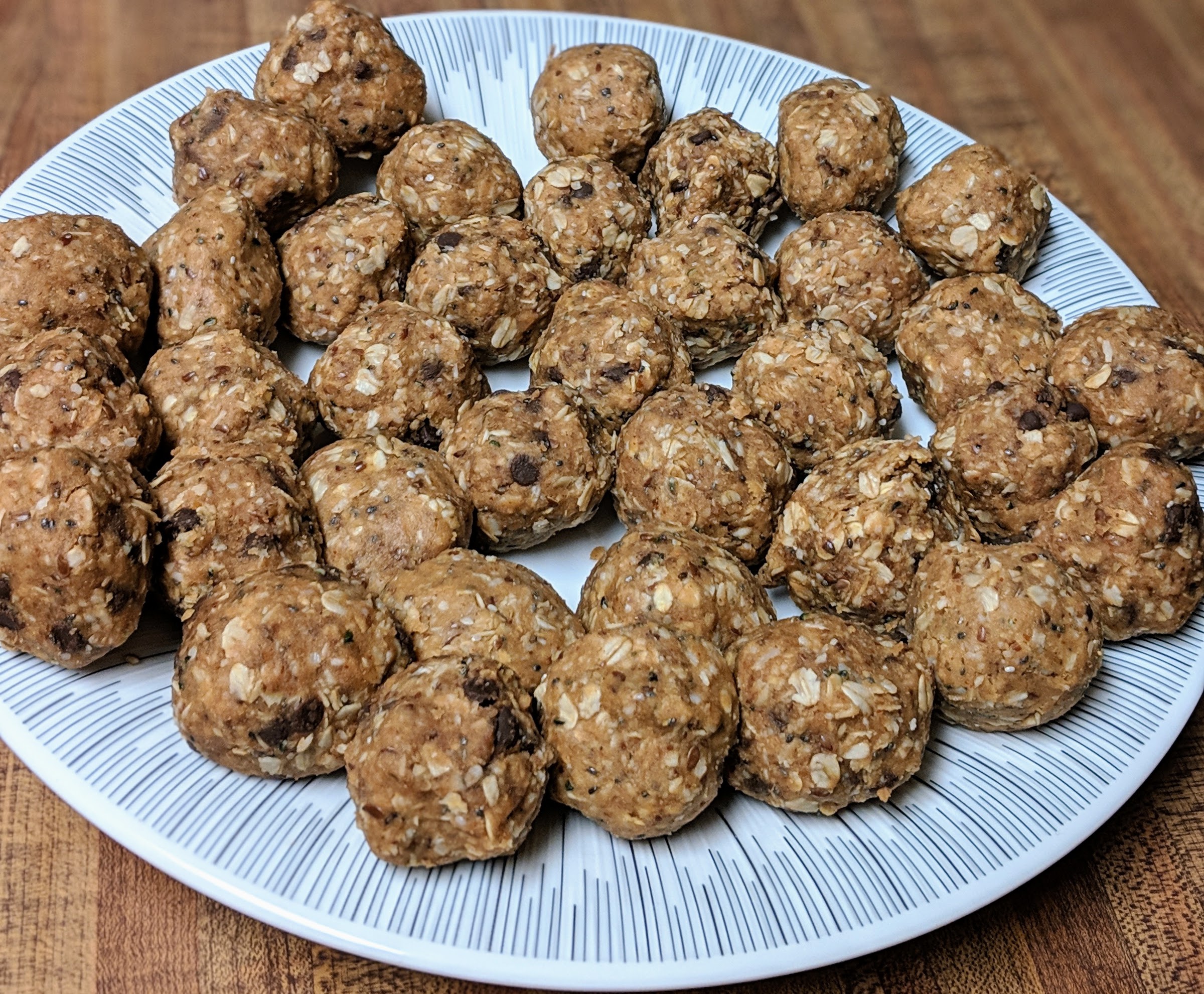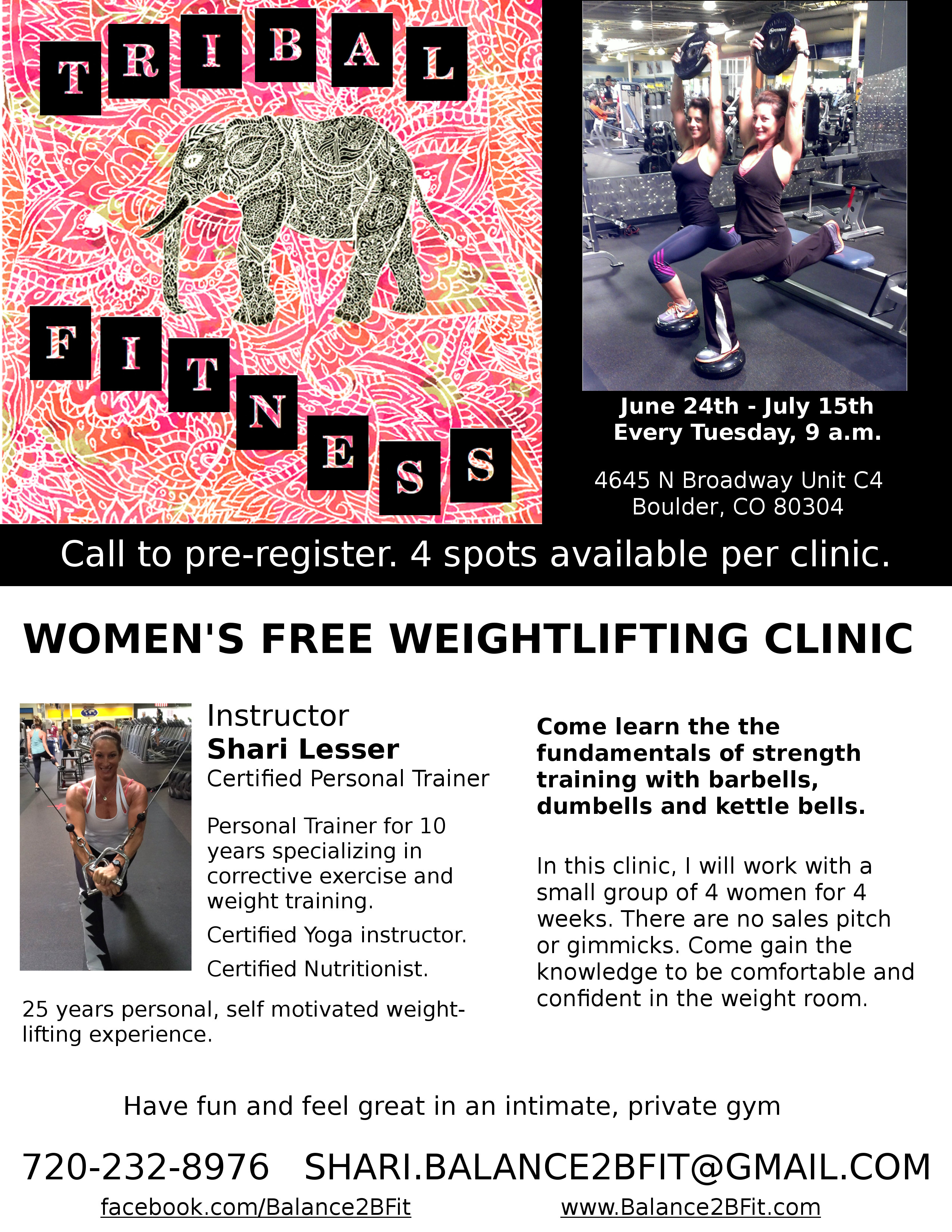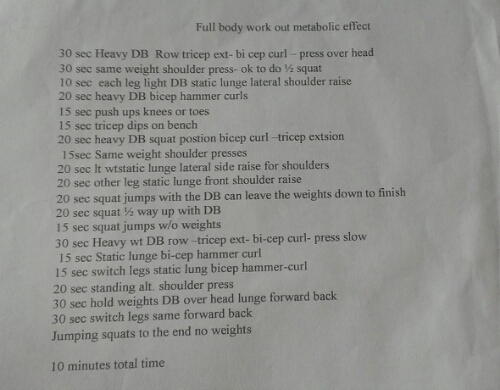I went to the Body Building show this past weekend! I was over whelmed with all the great competitors. The over 40 years old female class in figure was breath taking. So many women in there 40’s with new goals to compete and continue to lift heavy weight for fun and motivation to stay in the gym. I think I may have a new goal myself for next year. Over all the years in training, I realize just exactly how important It is to have a goal. No matter how big or small Just make one now!
All posts by Shari Lesser
Free weight lifting clinic
A party for Balance 2b fit
Another fun 10 min. work out
Fun quick work out
I did this work out yesterday! It was fun and quick.. I started with minimal energy then by the time I was finished I was pumped with a lot more than I started with.
Warm up’s fist and some down dog. I did each exercise with moderate weight!
•Barbell bench press 10 Reps
•Straight leg barbell deadlifts 20R
•30 inch Box jumps 10R
• Lying leg raises on bench for ABBS 20R
repeat 4X
then
•Front squats barbell worked on getting low in my squat 10-12R
•3 part DB chest press on Swiss Ball 8,8,8 R
•KB Swings 15R
•Prone jack knife on swiss ball 15R
repeat 4X
then
•DB chest flyes 15R
•More leg lifts on bench 15R
•Flying forearm pigeon 10R
Finished runners stretch and rolling back
DONE
Leave your questions and thoughts!
Shari
Easy No Bake Protein Energy Balls
Easy No Bake Protein Energy Bites

Ingredients
- 1 cup oatmeal – can use Gluten Free (GF)
- 1/3 C chocolate chips, coarsely chopped or (GF by Enjoy Life mini chips)
- 1/2 C toasted shredded coconut *I also rolled balls lightly in coconut
- 1/2 C peanut butter
- 1/4 C almond butter
- 1-2 scoops chocolate protein powder
- 1/4 C Honey or Agave
- 1/4 C ground flax seed
- 1/4 C hemp seeds
- 1 tsp vanilla
Directions:
Put vanilla, nut butters, and honey in bowl and stir up. I use my hands to mix well. Add all other ingredients to bowl and mix thoroughly. I mix by hand.
Roll it into small balls on wax paper. Recipe makes 12‐15 balls. Can freeze for several days.
NOTE: If the mixture is not moist enough to form a ball add a few drops of water to mixture.
Substitution ideas can abound for just about any of these ingredients! Feel free to substitute in your favorite nut butter (almond butter, sunflower seed butter, etc.) for the peanut butter. And you could also add in some wheat germ or chia seeds in place of some or all of the flax-seed. I would caution, though, against substituting agave nectar for the honey, as the honey’s thickness helps hold mix together.
Some other fun substitutions for the chocolate chips (or an addition to them) could include:
- chopped dried fruit (apricots, dates, raisins, etc.)
- dried berries (cranberries, cherries, etc.)
- chopped almonds, pecans, walnuts, or sunflower seeds
- other chips (butterscotch, dark chocolate, milk chocolate, white chocolate, M&Ms, etc.)
- other grains (different kinds of oatmeal, rice cereal, etc.)
Thrive, Show up & Participate
Thrive, Show up & Participate and see the changes happen!
A quick article and reminder Happy Spring and April fools!
Why should anyone strive to be more fully involved in his or her life? Well, for starters, the more you actively participate in your life with enthusiasm, the more youthful, vital energy will infuse your body. It is as if your inner child is so excited to see what the next day brings that he or she wakes you up bursting with joy and thrilled to be alive.
Exercise and consistency pay off! Be strong it is a wonderful feeling to have in your body! And it’s good for it, too. Your immune system will be hardier, your defenses stronger and your ability to bounce back from illness or injury vastly improved.
People love to be around those who are passionate and enthusiastic, so your social life may improve considerably. But best of all, you will get to enjoy the life you have created, and what could be more fun than that?
Keep Smiling!
Shari
If knee pain hinders you.
Great knee information from a well known knee Doctor. Tips to help keep your knees healthy!
http://movement-as-medicine.com/4-hip-mobility-drills-to-improve-your-squat/
Energy, Mitochondria and Toxicity & related HIIT Training
By Mark Hyman, MD (@markhymanmd) / December 2008
Editors’ note: For more than 15 years, celebrated author and pioneering medical visionary Mark Hyman, MD, has been practicing and promoting a revolutionary healthcare concept known as functional medicine. It’s a patient-centered (vs. disease-centered) approach that focuses on identifying and addressing the root causes of chronic health challenges as opposed to merely treating symptoms. Functional medicine also emphasizes incorporating nutrition and lifestyle solutions rather than relying exclusively on pharmaceutical and surgical interventions. Experience Life is proud to bring you this six-part series in which Dr. Hyman describes the emerging practice of functional medicine and explains how it can improve your well-being.
In the end, everything comes down to energy. I mean that quite literally: The ultimate loss of energy is death. And yet, most of us don’t think about energy this way — in terms of life and death. We don’t think much about where our energy comes from, why sometimes we have more or less of it, how it might affect our brains, or even how it might affect aging. But, in fact, everything we have explored in the other keys to well-being influences our health directly through energy. (See the preceding articles in this six-part series to the right.)
Imagine if you could find a way to tune up your metabolism, to increase your energy levels, to be able to think more clearly and to feel less achy. Imagine if you could prevent diabetes, heart disease, Parkinson’s disease and dementia. Imagine if you could heal fibromyalgia and chronic fatigue syndrome. Imagine if you could get to the root of aging and delay the whole process.
I’ve got news for you: All that and much more is possible if you’re willing to give yourself a metabolic makeover. You see, energy is something we lose with age. But it can also be lost because of anything that triggers more free radicals and oxidative stress or damage to our mitochondria.
Mito-who? Let me explain. In 2006, Harvard researchers found that the red pigment in grapes called resveratrol could extend life in mice by protecting their mitochondria. These mice actually lived 15 percent longer than average, even while eating a bad diet. In fact, they even became fitter and lost weight.
So how could they eat poorly and not exercise, but become fitter and live longer? One word: mitochondria. It turns out that the resveratrol protected and improved the function of the mitochondria through its effects on special master aging genes.
A Mitochondria Primer
Mitochondria are tiny factories that turn food and oxygen into energy. In each cell, there are hundreds to thousands of these little energy factories. They exist in greater numbers in active organs and tissues, like the muscles, heart and brain.
Simply put, the mitochondria are where metabolism happens. The role of your metabolism is to take the oxygen you breathe and the food you eat and process it to make energy, the fuel for life. Along the way, many things can go wrong that may impede your metabolism, make it run less efficiently or practically shut it down.
The problem? Mitochondria are very sensitive to damage. And when they aren’t working properly, you suffer all the symptoms of low energy — fatigue, memory loss, pain, rapid aging and more. Fatigue is the most common symptom of poorly functioning mitochondria. In fact, the reason we poop out as we age is the constant insult and injury we give our mitochondria.
But this doesn’t have to happen! Research shows that we can protect our mitochondria — and boost metabolism. Renowned scientist Bruce Ames, PhD, at the University of California, Berkeley, has spent the last decade discovering how we can give ourselves a metabolic tune-up. In a series of studies, he gave old, tired rats — who wouldn’t get on the treadmill anymore and couldn’t find the cheese in the maze or swim very far — two molecules that boost metabolism by making the mitochondria run better: alpha-lipoic acid and acetyl-L-carnitine.
In only a month, these rats began acting younger. They got up on the treadmill by themselves, swam long distances without tiring and could easily find the cheese in the maze, just like younger, healthier rats. How could that happen? The molecules used on the rats support a core part of our own biochemistry and thus affect our system as a whole, but they are not the only things needed to boost energy.
Oxidative Stress and Disease
To tune up your own metabolism, the first order of business is to find the things that damage your mitochondria — things like toxins, infections, allergens and stress. But the biggest insult over time is eating too much high-calorie, low-nutrient food — in short, too many “empty calories.”
When food is burned or metabolized with oxygen in the mitochondria, your body produces waste in the form of free radicals, which create a chain reaction of rusting, or oxidation. Unless you have enough antioxidants in your diet or you make enough in your body, you can’t protect yourself from the damage to your mitochondria. So when you eat empty calories — such as sugar, flour and processed foods that don’t have the high antioxidant levels of fruits and vegetables — you produce too many free radicals that tip the balance and start a chain reaction of cellular and tissue damage that destroys your mitochondria and, thus, your life force.
In short, oxidative stress is a slow, progressive process of deterioration that contributes to practically every known disease. It is part of the inevitable entropy, or chaotic breakdown, that is the basic principle of life.
You are already familiar with this process. You can see it in the rust on your car, the brown color that appears on an apple when cut open and exposed to air, the rancid vegetable oil in your cupboard, and even the wrinkles forming on your skin. But it doesn’t stop there. What you may not realize is that your own tissues are rusting, your own fats are going rancid, and your brain is effectively melting as you go about your daily life. OK, so it’s happening gradually, but still — perhaps you’re beginning to see the life and death connection I referred to earlier?
Your body does have a built-in anti-rusting system and mitochondrial protection system — the redox system, a chemical process of reduction and oxidation — but it can become overwhelmed by all the work you ask of it. As with all the systems in the body, big problems can arise when any one part of a system is thrown out of balance.
Reduction is the neutralization of damage from oxidation, or rusting. But oxidation is actually not all bad. In fact, your white blood cells kill bacteria and viruses by releasing hydrogen peroxide and other compounds we call free radicals. These are electrochemical molecules that are missing an electron, which makes them unstable and “lonely.” They bump into neighboring molecules and steal an electron, making them, in turn, unstable.
But while oxidation sometimes works in your favor, it can also easily get out of hand and start damaging the very tissues it was designed to protect. Eating too many empty calories and not taking in enough phytonutrients and antioxidants from fresh fruits and vegetables actively encourages your free radicals to multiply and run amok. The more free radicals you make, the less energy you produce, because you damage the cells’ ability to make energy in the mitochondria. This is why eating too many calories and not enough nutrients is at the heart of both obesity and a great deal of chronic illness.
Making the Most of Your Mitochondria
The key to achieving optimal health and enjoying a vital, energetic old age is to get your redox system back into balance and protect your mitochondria. Does that mean taking supplemental antioxidants is the answer? Not necessarily.
Much research has been done on antioxidants and disease — and the results are mixed. One problem is that we are used to looking at things through a pharmaceutical-drug lens, where you study a single drug, a single effect and a measurable outcome: You give a pill for high blood pressure and watch for blood pressure to go down. But studying a single antioxidant that we isolate from food, like beta-carotene, is completely counter-physiologic, because the body simply doesn’t process nutrients this way. It prefers to get its nutrients in whole-food form, where they come complete with all the necessary cofactors and complementary nutrients required for proper assimilation. And then there’s the fact that some of the most powerful antioxidants around — such as the proanthocyanidins in grapes and berries — are not available in supplement form.
Here’s another problem with relying on megadoses of supplemental antioxidants: By definition, antioxidants have the potential to becomes oxidants. That’s because an antioxidant works by giving up one electron to neutralize the free radical — and then, by definition, it becomes a free radical. It then needs to be neutralized by another antioxidant, moving down a chain until it is finally neutralized by the mother of all antioxidants, glutathione, which can be recycled and restored.
Ultimately, no magic pill will do for us what a whole-food diet and healthy lifestyle will, particularly given all the real-life insults affecting us — poor diet, stress, environmental toxins and sedentary lifestyle — all of which affect our mitochondria.
But if dosing up on bottled antioxidants isn’t the answer to our mitochondrial woes, what is? See the next page for my suggestions — and the lessons I learned from personal experience.
How to Heal Your Mitochondria
So now you know what can damage your mitochondria. Here’s how to protect them and prevent rusting.
First, address the causes of mitochondrial damage:
- Minimize your intake of processed food, junk food, sugar, empty calories, artificial sweeteners, artificial colors and other chemical food additives. Their toxic effects can damage your mitochondria and prevent them from producing energy properly.
- Detoxify. Support your body in ridding itself of the environmental and internal toxic “sludge” it has accumulated over the years. (For detox tips, see “Day-to-Day Detox” in the May 2008 archives.)
- Address inflammation. Chronic, smoldering inflammation slowly destroys our organs and our ability for optimal functioning, and leads to rapid aging. (For advice, see “Fighting Inflammation” in the July/August 2004 archives.)
- Balance your hormones. By resetting your metabolism and improving the way your body handles sugar and insulin — a master hormone — you can make your cells more intelligent and cooperative, and less resistant to doing their jobs.
Then, boost and protect your mitochondria:
- Exercise. In essence, exercising encourages your body to upgrade its energy factories. Interval training, for example, increases the efficiency and function of the mitochondria. (For more, see “The Fit Way to Weight Loss” in the January/February 2008 archives.)
- Eat food that’s full of antioxidants and phytonutrients. Get eight to 12 servings of fresh vegetables, fruits, beans, nuts, seeds and whole grains every day. (For more on this, see “Phyto Power” in the November 2007 archives.)
- Take mitochondria-protective and energy-boosting nutrients. These include acetyl-L-carnitine, alpha-lipoic acid, coenzyme Q10, n-acetyl-cysteine, NADH, D-ribose, resveratrol and magnesium aspartate. While not a cure-all, these nutrients, taken in conjunction with a whole-food, plant-based diet, can provide metabolic support for those low on energy.
- Increase omega-3 fats to help build your mitochondrial membranes. Coldwater fish, such as wild salmon, sardines and herring, are good sources of omega-3 fats, as are flaxseeds and omega-3 eggs. They all help strengthen the fragile cellular membranes that make your mitochondria work the way they’re supposed to.
Even as we are learning how mitochondrial injury is one of the common pathways to so many illnesses, we are also learning how to protect and defend ourselves. Getting a metabolic tune-up is not only possible, it’s also necessary for most of us to feel our best. Eating a colorful plant-based diet, reducing toxic exposures and getting adequate exercise are all key factors in protecting and restoring our energy metabolism to optimal function — and to enjoying the full, vibrant life force within our grasp.
Mark Hyman, MD, is the medical director and founder of The UltraWellness Center in Lenox, Mass., and the former medical director at Canyon Ranch health resort. He has authored several best-selling books, including UltraMetabolism: The Simple Plan for Automatic Weight Loss (Scribner, 2006), UltraPrevention: The 6-Week Plan That Will Make You Healthy for Life(Scribner, 2003), and The UltraSimple Diet (Pocket Books, 2007). His latest book, The UltraMind Solution: Fix Your Broken Brain By Healing Your Body First (Scribner), will be published early next year. Dr. Hyman also is editor in chief of the peer-reviewed journalAlternative Therapies and is a leading expert in functional medicine. For more information, seewww.ultrawellness.com/blog.
The Case of the Poisoned Doctor
Anything that is toxic is damaging to our mitochondria. I first learned this the hard way: I got very sick.
The first seeds of my chronic fatigue syndrome were sown in 1994, when I went to China to develop a medical center in Beijing. I had been to China a decade before, but since then, Beijing had changed from a city of 10 million wearing Mao jackets and riding bicycles to an even more crowded city filled with Audi limos, cell phones and business suits. The homes were heated by raw coal, sending a dark cloud over the city on the brightest winter days, and people walked the streets with surgical masks to filter out the black air.
At the time, I was unaware that coal burning is the most significant source of mercury emissions. I knew nothing of mercury, nor was I aware of a genetic polymorphism I have that makes it hard for me to detoxify.
It turns out that about half our population has this same polymorphism and is missing a key gene — GSTM1 — necessary for detoxifying mercury and many other 21st-century poisons. Because I am one of them, the entire time I was in China —breathing the polluted air, drinking polluted water and eating a lot of fish — mercury and other toxins were accumulating in my system.
Of course, I didn’t realize at the time that the mercury and my genes didn’t mix, setting the stage for my developing chronic fatigue syndrome two years later when I was back home in the Berkshire Mountains of western Massachusetts. I was exhausted and miserable, and I’d somehow gone from being a confident doctor to being a confused and frustrated patient.
My response was to begin researching my own case much as a detective would — digging into leads and following up on clues. Eventually I realized I was suffering from one of those diseases that most conventional doctors have been slow to acknowledge or name, much less effectively treat: chronic fatigue syndrome (CFS).
But it still wasn’t entirely clear to me how I could be suffering from so many seemingly unrelated symptoms while still failing to test positive for any diagnosable disease.
After a few years of searching for the cause of my illness, a colleague mentioned that many people with CFS are toxic. I took a urine test to see the total mercury load in my body, and what I discovered scared me.
“Normal” levels of mercury are less then 3 micrograms per liter (mcg/L). My level was almost 200 mcg/L. Anything over 50 mcg/L is considered “poisoning.” And one of the effects of that poisoning was to radically reduce the ability of my mitochondria to generate energy.
So I set about the process of unpoisoning myself. First, I did a lot of research and learning. I consulted with dozens of experts and then began experimenting with a careful, deliberate detoxification process that included detoxifying foods, supplements, intravenous glutathione and vitamin C, metal chelators, and saunas.
I was eventually able to rid my body of mercury and heal my mitochondria. Meanwhile, I also worked on healing my gut by eliminating food allergens, and by using probiotics and enzymes.
This journey to health took me from learning about and addressing my body’s nutritional biochemistry and cellular biology to a process of psychological and spiritual renewal. It allowed me to heal completely and gave me the basis from which I now help to heal others.
Struggling with and fully recovering from a chronic problem that is often considered incurable, I learned how to work with every system of the body — one of the hallmarks of functional medicine. (See “The 7 Keys to UltraWellness,” below, for an overview of our bodies’ core systems.)
Too often, patients are given diagnoses that are quick or superficial health assessments. But because I learned firsthand what it’s like to suffer from what are called “nondiagnosable” conditions, I have become much more empathetic and thorough with my own patients.
As I look back on the entire experience, I realize that my poor health offered me an opportunity to learn how to cure both myself and others. It is my hope that the field of functional medicine will bring this sort of patient-centered healing to all those who long for the full return of their vitality, energy and resilience. — Mark Hyman, MD
The 7 Keys to UltraWellness
Simply put, when your core systems are out of balance, they make fertile ground for the roots of illness. When they are in balance, they become the keys to creating wellness and vitality:
- Environmental Inputs (diet, lifestyle, toxins, stress and trauma)
- Inflammation and Immune Balance (the hidden fire within)
- Hormone and Neurotransmitter Balance (insulin, thyroid, adrenal balance; sex hormones and mood chemicals)
- Gut and Digestive Health (digestion, absorption, assimilation, intestinal ecosystem and the gut-immune system)
- Detoxification Imbalances and Function (getting rid of wastes and dealing with toxins)
- Creating Energy (the source of life energy and metabolism — antioxidant balance)
- Mind-Body/Body-Mind Connection (change your mind, change your body; change your body, change your mind)
Learn more about the fundamentals of functional wellness by reading the preceding articles in this six-part series, listed at the top right of this page.
Happy New Year!
This year make your New Years resolution a life changer! Commit to your body and mind. Know that sitting takes years away. Add years to your life with exercise, movement and laughter. In our week, we have 168 hours . We sleep roughly 56 of those hours. Your awake time is also roughly 112 hours. I suggest spending 7 hours exercising during your week. In the bigger picture, this is a small dedication to add life to your years and give your body the best anti-aging benefit there is out there! Choose a large goal for the year and small goals throughout to keep you motivated. Remember your eating to fuel your system, stay healthy and to promote your exercise time. Laughter is good for your soul, heart and body. Laugh, laugh, laugh! Thank you for a wonderful year of allowing me the opportunity in watching your bodies improve and change to a remarkable you. I look forward to 2014 with lots of great exercises, pain – fun and laughter!
Shari!
Contact Me
[contact-form to=’shari.balance2bfit@gmail.com’ subject=’Website Contact Form’][contact-field label=’Name’ type=’name’ required=’1’/][contact-field label=’Email’ type=’email’ required=’1’/][contact-field label=’Comment’ type=’textarea’ required=’1’/][/contact-form]





